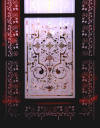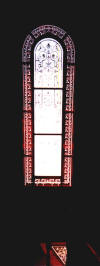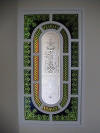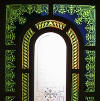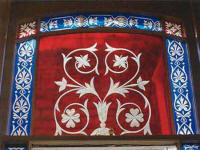Flashed Glass - an introductionAuthor: Rick Martin Posted: Revised: August 03, 2005 Traditionally, flashed glass was produced for the art glass trade to provide a cheaper method of making colored glass panes ie.one could layer a thin coating of color on an inexpensive base of clear glass, the finished product when held up to the light was practically indistinguishable from solid color glass. Red flash was the first most commonly used due to the expense of producing the red pigments, the purest red was often too dark and flashing also helped lighten the color, gold powders providing the best reds. Many other colors blues and yellows were also produced, more so than today, though having said that, over the years I’ve collected a good selection of flashed colors. These mouthblown glasses attain their coloration through the "flash" technique of glass blowing. One or more colored glasses are applied to a clear or colored base glass referred to as the "carrier glass". This method makes possible a great variety of glasses. Multicolored glass, glass with shading, cloudy or torn glass, seeded glass, multicolored flashes and streaky all may be produced using this method. White "milk" or opal glasses are made color flashed on opaque or translucent carriers, these obscure views but allow light transmission, useful in cases such as landing windows where light levels are factors to be considered or privacy windows and doors. ProductionThe first step is to pick up the molten flash color with the blowpipe. The shape of this initial gather determines the final appearance of the flashed glass. A round balloon results in even flashing throughout the sheet, a pear shape gentle shading and a "notched" mass creates the "torn" appearance. The base color glass is then gathered over the carrier flash color gather and blown out into cylinder shape. Throughout the process, the glassblower must consider the final intended appearance of the flash. After the blowing of the cylinder, the steps of production are identical to those of Genuine Antique Glass. The precise control of form and color of the flash requires considerable experience as well as the skilled craftsmanship of the glassblower” Nowadays flashed glass is still in production though on a very small scale, and now ironically the most expensive of all art glass, doubtless due to the expertise and intense labor involved in making the larger commercial sized panes it is usually supplied in. 80 X 100cm approx. The main commercial sources remain the St Gobain, and Lamberts though other smaller private sources exist. St. Just Produce a range of mouth
blown glasses from France.
This manufacturer being acknowledged as making the best flashed glass
available. This is due to a very thin layer of flashed color which results in
easy and controllable aciding to lighten or (sandblast) remove this color.
Sheet size varies 730mm x 860mm (29" x 34"). Fine line carving on blue/green flashed Working with flashed glassEarly and present day uses in stained glass studios were to achieve high detail in heraldics etc, or the fine details of flowers, simple brilliant cutting, flash lines and star flashes etc were used up to the 30’s-40’s in the UK. These are still commercially available in small square decorative styles generally used as corner insert pieces and mostly in restoration work, commercially acid etched border panels for simpler door & small window work were once available. Flashed glass is of course also used in traditional Leaded stained glass work for its special qualities and in certain areas, for effect. Traditional commercial panelsTo achieve controlled tonal effects on flashed glass diluted Hydrofluoric acids were traditionally used. Carefully timed biting or rotting down through the flashed layer washing off when the required tone was reached provided one with a choice of tones between the flashed layer and the base color, these tones become critical when biting the last microns of depth. One must observe carefully and flood-wash off the areas when the desired tone is reached. It is a great loss that it is an almost abandoned process nowadays, due mainly to the inherent dangers of working with HF acid. For the sandcarver working with stencils one must take care of flashed layer depth, as it often varies, mostly depending on the cut of sheet, at times one can carve to 0.5-1.7mm before reaching base color and extra care must be taken at every stage as the glass can vary in overall thickness. It is not advisable to work on single large panels as flashed glass is not always flat, rather one should economize on the glass sizes within the design, this can add to effective contrasts, leaving room for other mixed surface techniques.
Examples of Recent Antique flashed glass windows by the Author Modern Day usesUsing antique flashed glass in the creation of windows certainly gives the sandblast craftsman the added pleasure of bright solid color to work with in combination with a secondary base color. The main set back will always be the cost as this fine glass is amongst the most expensive available. For decorative work on a larger scale one must acquire and inspire patrons prepared to invest and who appreciate the value of such decorative windows as an investment in beauty for their homes. I hope this overview may be of some help to see the decorative potentials of carved flashed glass use in modern homes and hasten its return as a decorative alternative. Rick Martin (Madeira 2004)
|
|
©2005 Graydog Services • webmaster: jim(at)graydog(dot)org |




